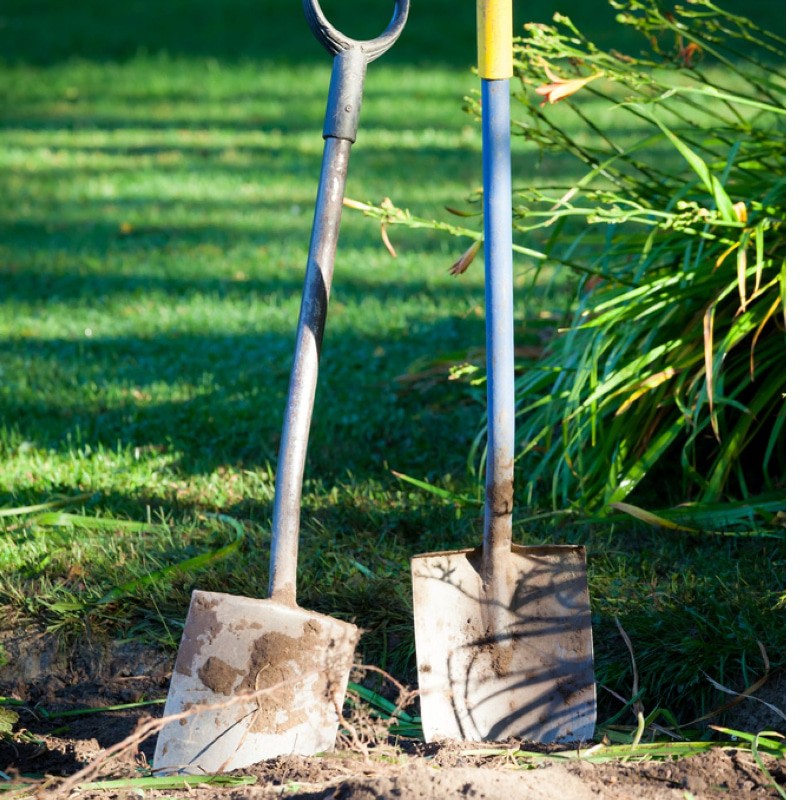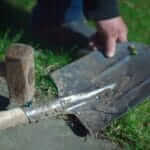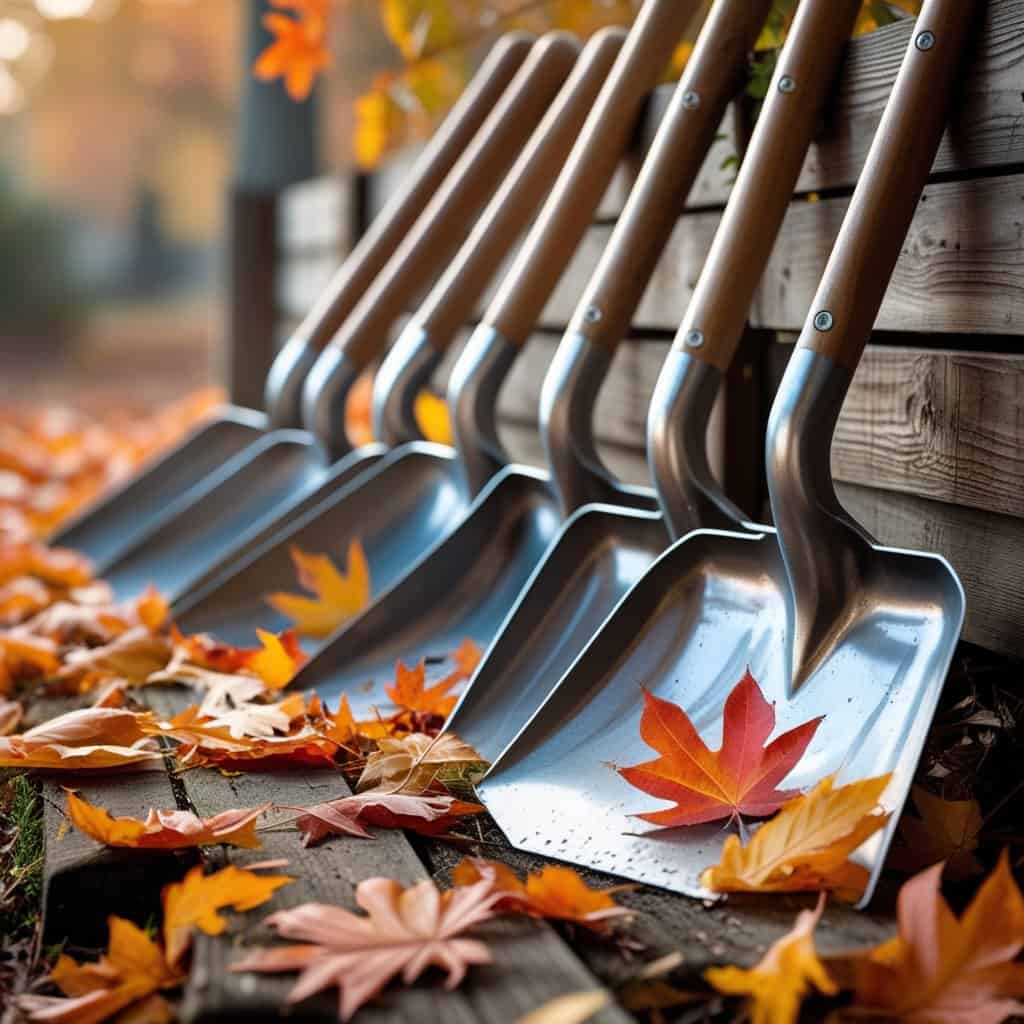A trenching shovel and a drain spade, like cousins, are closely related; however, they do have quite a few differences that can save you time and energy if you know how to capitalize on their differences.
People are easily confused about what shovel they should use because the term shovel is used to describe all shovels and remains ill-defined; thank goodness for Google, right?
Many seasoned gardeners have a drain spade and trenching shovel in their tool shed, but how do they know when to use them?
Table of Contents
A Drain Spade
What is a Drain Spade?
Drain spades feature a thin blade with bent sides that curve inward, making it ideal for scooping dirt, transplanting plants, weeding in tight spaces and creating trenches. This spade is also called a tile spade.
As the spade is narrow, running it horizontally, you can scoop up the soil that falls into the trench for easy removal. The amount of dirt you can catch in the blade affects the weight you are putting on your back, so ensure that you do not use a large drain spade to ensure less fatigue while moving dirt.
The blade’s tip is circular, making it useful for focusing on one specific spot of work. This spade is also great when you want to transplant a piece of your favorite flowers but don’t want to disturb your flowers’ whole root system. As the space is tight, this blade’s narrowness allows you to remove a portion of the plant to transplant elsewhere.
Size of a Drain Spade
On average, the blade’s size on a drain spade is 7.3 cm (2 in.) wide by 21.6 cm (8 in.)
Where to Use a Drain Spade
It is excellent for work in a focused area without bothering another plant or location:
Removing weeds
Adding items to a garden such as blossoms in an exact spot
Clearing out debris in existing trenches
Transplanting plants from one spot to another
Edge the lawn or define a garden space
Best Features of a Drain Spade
The handle and blade of a drain spade vertically line up, making it ideal for thrusting the spade straight down into the earth.
The straight angle means you can create beautiful looking edges on your lawn or around your garden edges.
The blade’s top has a rounded or rolled edge, allowing you greater control and the ability to utilize your foot to push the blade into the soil and turn at an angle to cut through dirt and roots.
Spades are ideal for defining a trench’s edges on either side, clearing out rocks, weeds and debris. Not only can they smooth the edges of the waste, but scoop it out.
Trenching Shovel
What is a Trenching Shovel?
A trenching shovel has square edges that move up into a sharp, pointy tip.
It is like a rectangle with one of the short sides pointing out in a triangle.
The sharp point is to penetrate the soil, effectively dislodging dirt to make way for the blade’s body.
Size of a Trenching Shovel
Trenching shovel blades are generally about 10.16 cm (4 in.) wide and 45.72 cm (18 in.) tall
Where to Use a Trenching Shovel
The squared body of the blade forms the width of the trench itself.
The wider the blade, the wider the groove.
The shovel blade curves inward to help carry dirt away. Again, you will want to be aware of how much weight you are lifting with the blade to avoid over-exertion.
A trenching shovel has a bigger and broader blade than found on a spade as it moves more substrate and creates a bigger hole.
Unlike the drain spade, the trenching shovel is not used for precise work in an area, making it ideal for:
Laying drainage tiles
Irrigation pipes
Digging gardening trenches
Digging up deeply-rooted plants
Best Features of A Trenching Shovel
Some trench shovels are V-shaped, which can be a bit awkward to get used to at first.
The shape is perfect for putting pressure on the blade with your boot to cut into the soil and dig deep.
Shovels will dig a wider hole than spades because of the width and evenly distribute a dig because it covers more area.
Key Differences Between A Drain Spade And A Trenching Shovel
Both the drain spade and trenching shovel can quickly help you navigate your way through a trench. Although they are similar, there are a few key differences.
Size, weight, and cost will vary from manufacturer to manufacturer, the distinguishing features between the two will be the blade style and the handle.
Each of these will play a vital role in how well the tool is suited for reducing the amount of exertion you must put into the task. Learning the differences will allow you to know when to use them in each situation and optimize your skillset.
When cutting through roots and rocky ground, pointed blades are more effective in slicing through the soil whereas, flat blades are perfect for lifting and edging the loosened material.
Sharper blades are also more precise, while wider blades don’t zone in on an area.
Handles will also make a difference in how you dig. D-molded handles prevent your hands from slipping. Longer, light-weight handles provide better leverage, which is easier on your back.
The shape of the handle matters too. A safety-grip handle is essential, so you maintain control of your spade or shovel. Wearing gloves during the process to prevent slippage and protect your hands is highly advised.
Trenching is all about leverage, so working with the right blade and handle will make the job a lot less labour-intensive.
Due to the blade’s shape, a spade will create a trench with a rough, round bottom. Trenching shovels form a more smooth, flat base.
The bottom surface may not matter if you are putting in pipes, but it will matter if you are placing plants or seeds in the trench.
A spade and a shovel both function to scoop up the soil. The easy way to remember the significant difference which set them apart is by saying that: shovels dig, and spades slice and scoop.
This simple saying will help you pick the right tool for the job every time.
The key differences come into play when you need to work in a tight area.
If you are working in an exact spot around a plant in the garden, a spade is the better choice.
If you are digging a long trench, the shovel is the better choice.
You Need Both A Spade And A Shovel
It is essential to have the proper tool for the job, and in the case of trenching, you need both a shovel and a spade in your bag of tricks.
The spade compliments the shovel because its strengths are the shovel’s weaknesses and vice versa. Going in fully prepared makes all the difference in the world.
Drain Spade vs Trenching Shovel Use Examples
Example 1
As you sit and ponder a space in your backyard where you want to place a trench, grab the trenching shovel.
Grip it and rip it. Use your boot to firmly dig into the soil and trench away, clearing the ground, root, and rocks as you go.
Now that you have a trench, it needs to be defined, so you grab the spade and define the edges, scooping out all of the loose soil you cut free as you go.
Before you know it, you have a wonderfully excavated trench that is defined and ready for use.
Example 2
On the other hand, if you are working in the garden and decide that your blossom arrangement is out of whack because the blues are with the reds and they should be with the greens, you need a spade.
The spade provides the precision to accurately transport those naughty blossoms where they belong to enhance the aesthetic value of your garden.
To dig the hole for those blossoms, you will want the shovel to create the perfect new home.
Gardeners, landscapers, and DIY adventurers come with a complete arsenal of shovels and spades of all sizes.
Although the term spade and shovel are commonly used interchangeably, their uses are quite different.
It’s not really about deciding on one or the other and more about choosing which one for the specific task at hand.
Think of yourself as being an efficiency expert in your tool selection with a shovel in one hand and a spade in the other.
To master the job, you will need both.






